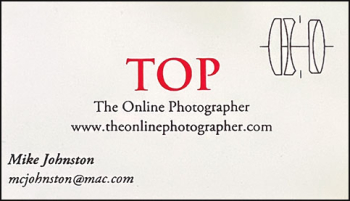Thought you might like to see my business card. The domain name and email address are the two things that don't change; for address and telephone number I use a rubber stamp on the back of the card. That way I can use the same card through different house moves (two so far).
The logo or, er, "logo" is the block diagram for the 1902 Zeiss Tessar designed by Paul Rudolph and his assistant Ernst Wandersleb. Pretty sure I couldn't use it as a logo online even though it's in the public domain, because I wouldn't be able to assert copyright, but hidden in the person-to-person relationship of a business card it flies below radar. The higher profile anything is, the more robust it has to be in standing up to scrutiny. In any event I can claim it's a decoration for the card rather than a logo. Because that's true. I grabbed it at the last minute because the printer thought the upper right corner was too empty.
The printing is "raised" and glossy but I can't recall the process. I had it made by a shop in Wisconsin that's been in business since 1948. It's 99% percent certain this is going to remain my business card until, um, organic expiration; I have roughly a 110-year supply. :-)
Mike, thriving as an organism
Original contents copyright 2025 by Michael C. Johnston and/or the bylined author. All Rights Reserved. Links in this post may be to our affiliates; sales through affiliate links may benefit this site. As an Amazon Associate I earn from qualifying purchases. (To see all the comments, click on the "Comments" link below or on the title of this post.)
Featured Comments from:
Alan: "Thermographic printing, or simply 'thermo,' is the name of the process you’re after."
Dan Khong: "The 'TOP' is eye-catching. Not using your name right in the centre (like almost 99% of people out there) shows humility. I respect that in a person. The Tessar lens design is also my favourite. It's simple, elegant and can be a conversation starter. Overall, a very well thought out and elegant design for a name card."
Mike replies: Thank you Dan! Note my lack of humility in Featuring your comment.




What could be better – a Tessar Lens diagram !!
Posted by: Peter | Friday, 21 March 2025 at 10:32 AM
I'll ask my brother (former Graphic Designer) for his critique. :>)
Posted by: Dave | Friday, 21 March 2025 at 10:33 AM
I thought I recognized the Tessar optical diagram. I knew it quite well, in the form of the Mamiya Sekor 135mm f/4.5 lens for the Mamiya TLR system. The lens was sharp sharp sharp. Because it was used as a long-focus lens (not a telephoto) only the best part of the image circle (the center) was used for imaging. It didn’t have the best multi coating, but didn’t need it. There were few lens-air surfaces, and the lens had to be racked out quite far from the film plane, so internal reflections were never really an issue. Ah, memories!
Posted by: Craig Yuill | Friday, 21 March 2025 at 10:50 AM
It's kind of old-school, but it's good old-school, and it's not like this blog spends its time chasing the latest fad of the moment (always excepting film!).
I like the reverse diagonal, and I like that it puts the contact information in the lower left corner. I normally go with all the contact info on the basic card, but there are lots of reasons why people might not, including moving house.
I use cards slowly enough that I just print them on pre-scored inkjet blanks, which gives me different tradeoffs for how long the design has to be stable for. And it means I don't get the nice raised print (I still think of that as faking printing from an engraved master, but I'm sure only insane high-end places still actually do exactly that).
I'm now investigating using NFC to transfer contact info to people's phones, either directly from my phone, or with a customized NFC disk I can make with my phone and some free software. I've done that for the guest WIFI setup in my house, visitors can just tap their phone to the sign and get signed in. I've got many blank disks left over from the WIFI project.
Posted by: David Dyer-Bennet | Friday, 21 March 2025 at 12:39 PM
Let's see Paul Allen's card.
https://youtu.be/YHgwxVCiMyI?si=Wq8e1eSutQsyVPD3
I can't be the only reader that immediately thought of this scene from American Psycho and the 10,000 memes that it's spawnned.
https://youtu.be/D_HNpheUjBU?si=Tm0_m492NUE5cVbm
Posted by: David Raboin | Friday, 21 March 2025 at 03:49 PM
I got business cards one time in my life while working for the USGS. Like you, it was a large supply. Soon after the funding for my project dried up and within a few months nothing on the card except my name was correct or useful. Then I had a lifetime supply of high-quality bookmarks.
Posted by: ASW | Friday, 21 March 2025 at 05:30 PM
Over the years I’ve had different strategies for cards. I succumbed to an order or two of those arty M** cards. Now I purchase photo paper-specific Avery card blanks. They are inexpensive and allow me to easily change the photo I chose for the card and any other info. I can print a sheet of ten at a time, each with a different photo if I’d like. When I have had photos in an exhibition, I use the photos from the exhibition - better for people to remember me and my work.
Posted by: Kristine Hinrichs | Saturday, 22 March 2025 at 12:34 PM
From YouTube, the buisness card scene from American Psycho demonstrating the politics of having the "best" card among contemporaries.
https://youtu.be/aZVkW9p-cCU?si=ddtX7edGeyW2gycS
Posted by: Albert Smith | Saturday, 22 March 2025 at 04:44 PM